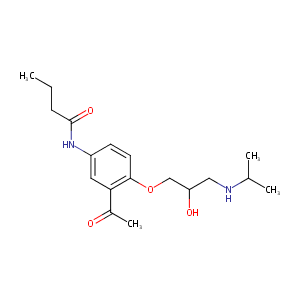Details of the Drug
General Information of Drug (ID: DM0TI4U)
| Drug Name |
Acebutolol
|
||||||||||||||||||||||||||
|---|---|---|---|---|---|---|---|---|---|---|---|---|---|---|---|---|---|---|---|---|---|---|---|---|---|---|---|
| Synonyms |
Acebrutololum; Acebutololo; Acebutololum; Acetobutolol; Neptal; Prent; Sectral; Acebutolol HCL; RP 21823; Acebrutololum [INN-Latin]; Acebutololum [INN-Latin]; Acetobutolol [INN-Spanish]; Dl-Acebutolol; M & B 17803A; Prent (TN); Sectral (TN); Acebutolol (USAN/INN); Acebutolol [USAN:INN:BAN]; M&B-17803 A; N-(3-Acetyl-4-[2-hydroxy-3-(isopropylamino)propoxy]phenyl)butanamide; N-[3-acetyl-4-[2-hydroxy-3-[(1-methylethyl)amino]propoxy]phenyl]butanamide; N-[3-acetyl-4-[2-hydroxy-3-(propan-2-ylamino)propoxy]phenyl]butanamide; N-{3-acetyl-4-[2-hydroxy-3-(propan-2-ylamino)propoxy]phenyl}butanamide; (+-)-3'-Acetyl-4'-(2-hydroxy-3-(isopropylamino)propoxy)butyranilide; (+-)-Acebutolol; (+-)-N-(3-Acetyl-4-(2-hydroxy-3-((1-methylethyl)amino)propoxy)phenyl)butanamide; 1-(2-Acetyl-4-n-butyramidophenoxy)-2-hydroxy-3-isopropylaminopropane; 3'-(Acetyl-4'-(2-hydroxy-3-(isopropylamino)propoxy)butyranilide; 3'-Acetyl-4'-(2-hydroxy-3-(isopropylamino)propoxy)butyranilide; 3'-Acetyl-4'-(2-hydroxy-3-isopropylaminopropoxy)butyranilid; 5'-Butyramido-2'-(2-hydroxy-3-isopropylaminopropoxy)acetophenone
|
||||||||||||||||||||||||||
| Indication |
|
||||||||||||||||||||||||||
| Therapeutic Class |
Antihypertensive Agents
|
||||||||||||||||||||||||||
| Drug Type |
Small molecular drug
|
||||||||||||||||||||||||||
| Structure |
 |
||||||||||||||||||||||||||
| 3D MOL | 2D MOL | ||||||||||||||||||||||||||
| #Ro5 Violations (Lipinski): 0 | Molecular Weight (mw) | 336.4 | |||||||||||||||||||||||||
| Logarithm of the Partition Coefficient (xlogp) | 1.7 | ||||||||||||||||||||||||||
| Rotatable Bond Count (rotbonds) | 10 | ||||||||||||||||||||||||||
| Hydrogen Bond Donor Count (hbonddonor) | 3 | ||||||||||||||||||||||||||
| Hydrogen Bond Acceptor Count (hbondacc) | 5 | ||||||||||||||||||||||||||
| ADMET Property |
|
||||||||||||||||||||||||||
| Adverse Drug Reaction (ADR) |
|
||||||||||||||||||||||||||
| Chemical Identifiers |
|
||||||||||||||||||||||||||
| Cross-matching ID | |||||||||||||||||||||||||||
Molecular Interaction Atlas of This Drug
 Drug Therapeutic Target (DTT) |
|
||||||||||||||||||||||||||||||||||||
|---|---|---|---|---|---|---|---|---|---|---|---|---|---|---|---|---|---|---|---|---|---|---|---|---|---|---|---|---|---|---|---|---|---|---|---|---|---|
 Drug Transporter (DTP) |
|
||||||||||||||||||||||||||||||||||||
 Drug-Metabolizing Enzyme (DME) |
|
||||||||||||||||||||||||||||||||||||
 Drug Off-Target (DOT) |
|
||||||||||||||||||||||||||||||||||||
| Molecular Interaction Atlas (MIA) | |||||||||||||||||||||||||||||||||||||
Drug-Drug Interaction (DDI) Information of This Drug
|
Coadministration of a Drug Treating the Same Disease as Acebutolol
Coadministration of a Drug Treating the Disease Different from Acebutolol (Comorbidity)
|
|||||||||||||||||||||||||||||||||||||||||||||||||||||||||||||||||||||||||||||||||||||||||||||||||||||||||||||||||||||||||||||||||||||||||||||||||||||||||||||||||||||||||||||||||||||||||||||||||||||||||||||||||||||||||||||||||||||||||||||||||||||||||||||||||||||
Drug Inactive Ingredient(s) (DIG) and Formulation(s) of This Drug
References
| 1 | Drugs@FDA. U.S. Food and Drug Administration. U.S. Department of Health & Human Services. 2015 | ||||
|---|---|---|---|---|---|
| 2 | Acebutolol FDA Label | ||||
| 3 | BDDCS applied to over 900 drugs | ||||
| 4 | Trend Analysis of a Database of Intravenous Pharmacokinetic Parameters in Humans for 1352 Drug Compounds | ||||
| 5 | Estimating the safe starting dose in phase I clinical trials and no observed effect level based on QSAR modeling of the human maximum recommended daily dose | ||||
| 6 | ADReCS-Target: target profiles for aiding drug safety research and application. Nucleic Acids Res. 2018 Jan 4;46(D1):D911-D917. doi: 10.1093/nar/gkx899. | ||||
| 7 | Prediction and experimental validation of acute toxicity of beta-blockers in Ceriodaphnia dubia. Environ Toxicol Chem. 2005 Oct;24(10):2470-6. | ||||
| 8 | Implications of genetic polymorphisms in drug transporters for pharmacotherapy. Cancer Lett. 2006 Mar 8;234(1):4-33. | ||||
| 9 | Fruit juice inhibition of uptake transport: a new type of food-drug interaction. Br J Clin Pharmacol. 2010 Nov;70(5):645-55. | ||||
| 10 | Human intestinal transporter database: QSAR modeling and virtual profiling of drug uptake, efflux and interactions. Pharm Res. 2013 Apr;30(4):996-1007. | ||||
| 11 | Application of substrate depletion assay to evaluation of CYP isoforms responsible for stereoselective metabolism of carvedilol. Drug Metab Pharmacokinet. 2016 Dec;31(6):425-432. | ||||
| 12 | Selection of drugs to test the specificity of the Tg.AC assay by screening for induction of the gadd153 promoter in vitro. Toxicol Sci. 2003 Aug;74(2):260-70. doi: 10.1093/toxsci/kfg113. Epub 2003 May 2. | ||||
| 13 | Addition of acebutolol to diuretics in hypertension. Clin Pharmacol Ther. 1981 Dec;30(6):739-44. doi: 10.1038/clpt.1981.232. | ||||
| 14 | Anastassiades CJ "Nifedipine and beta-blocker drugs." Br Med J 281 (1980): 1251-2. [PMID: 6107167] | ||||
| 15 | Conrad KA, Nyman DW "Effects of metoprolol and propranolol on theophylline elimination." Clin Pharmacol Ther 28 (1980): 463-7. [PMID: 7408406] | ||||
| 16 | Aronowitz JS, Chakos MH, Safferman AZ, Lieberman JA "Syncope associated with the combination of clozapine and enalapril." J Clin Psychopharmacol 14 (1994): 429-30. [PMID: 7884028] | ||||
| 17 | Chapple DJ, Clark JS, Hughes R "Interaction between atracurium and drugs used in anaesthesia." Br J Anaesth 55 Suppl 1 (1983): s17-22. [PMID: 6688011] | ||||
| 18 | Canadian Pharmacists Association. | ||||
| 19 | Cerner Multum, Inc. "UK Summary of Product Characteristics.". | ||||
| 20 | EMEA. European Medicines Agency "EPARs. European Union Public Assessment Reports.". | ||||
| 21 | Branch RA, Herman RJ "Enzyme induction and beta-adrenergic receptor blocking drugs." Br J Clin Pharmacol 17 (1984): s77-84. [PMID: 6146342] | ||||
| 22 | Cerner Multum, Inc. "Australian Product Information.". | ||||
| 23 | Product Information. Gilenya (fingolimod). Novartis Pharmaceuticals, East Hanover, NJ. | ||||
| 24 | Product Information. Zeposia (ozanimod). Celgene Corporation, Summit, NJ. | ||||
| 25 | Dean S, Kendall MJ, Potter S, Thompson MH, Jackson DA "Nadolol in combination with indapamide and xipamide in resistant hypertensives." Eur J Clin Pharmacol 28 (1985): 29-33. [PMID: 3987783] | ||||
| 26 | Chrysant SG "Experience with terazosin administered in combination with other antihypertensive agents." Am J Med 80 (1986): 55-61. [PMID: 2872808] | ||||
| 27 | Product Information. Clozaril (clozapine). Novartis Pharmaceuticals, East Hanover, NJ. | ||||
